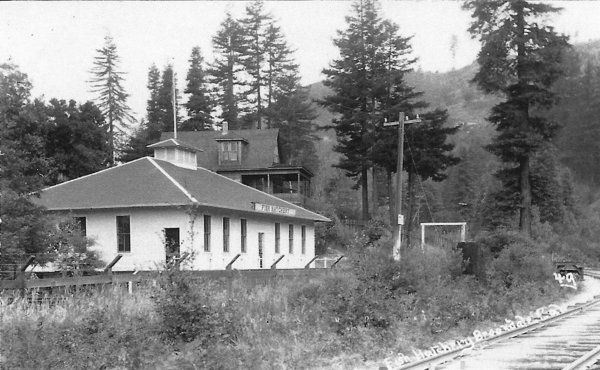
When one thinks of the small mountain community of Brookdale, various things may come to mind such as the Brookdale Lodge, ghost stories, celebrities, or swimming holes. One thing that certainly falls to the wayside is trout.
Right around the time of the 1906 San Francisco earthquake, San Lorenzo Valley residents and the Southern Pacific Railroad, working with the California Fish and Game Commission, felt that Brookdale was an ideal trout-breeding locale. Village founder John H. Logan donated land in 1905 and breeding tanks were installed soon after.
The fish hatchery sat alongside the railroad tracks off Berkeley Way at a place called Steen’s Spur. Jacob Steen owned a mercantile store in Felton, but his Steen & Company operations in Brookdale were focused on stumping — the removal of mostly timbered trees so that they could not regrow in the area.
Steen’s Spur also serviced a small fish-breeding pond that had operated since at least 1894. The larger hatchery quickly made the pond obsolete.
Eggs brought in from brooding ponds on Scotts Creek north of Davenport provided the essential ingredient for the hatchery.
The success of the hatchery was immediate, but a lack of growing ponds meant that the young fish were released directly into the San Lorenzo River and other nearby creeks. The ponds were built before the next growing season.
By 1910, over two million steelhead trout were born annually at the hatchery. Newborn fingerlings were loaded into waiting boxcars and shipped to streams throughout the Central Coast.
Brookdale’s facility was smaller than most others in the state, but it focused on experimenting with new foods in an attempt to promote faster and greater growth among the fish. The facility also developed into a tourist trap for aspiring anglers.
It is likely that the railroad spur was removed within a few years of the facility’s opening when the tracks were standard-gauged. By 1915, the Fish and Game Commission had taken control of the facility after the Southern Pacific ceased its subsidy. Rail access to the site continued until the line was abandoned in 1934. Trucks shipped the fingerlings after that date.
Increased costs forced the facility to finally shut its doors in 1953 after nearly 50 years in service. The property reverted to John Logan’s heirs, and portions of the facility survive today as private residences.
– Derek Whaley is a local historian specializing in the railroading past of Santa Cruz County. For more information, visit his website at http://www.SantaCruzTrains.com/.











